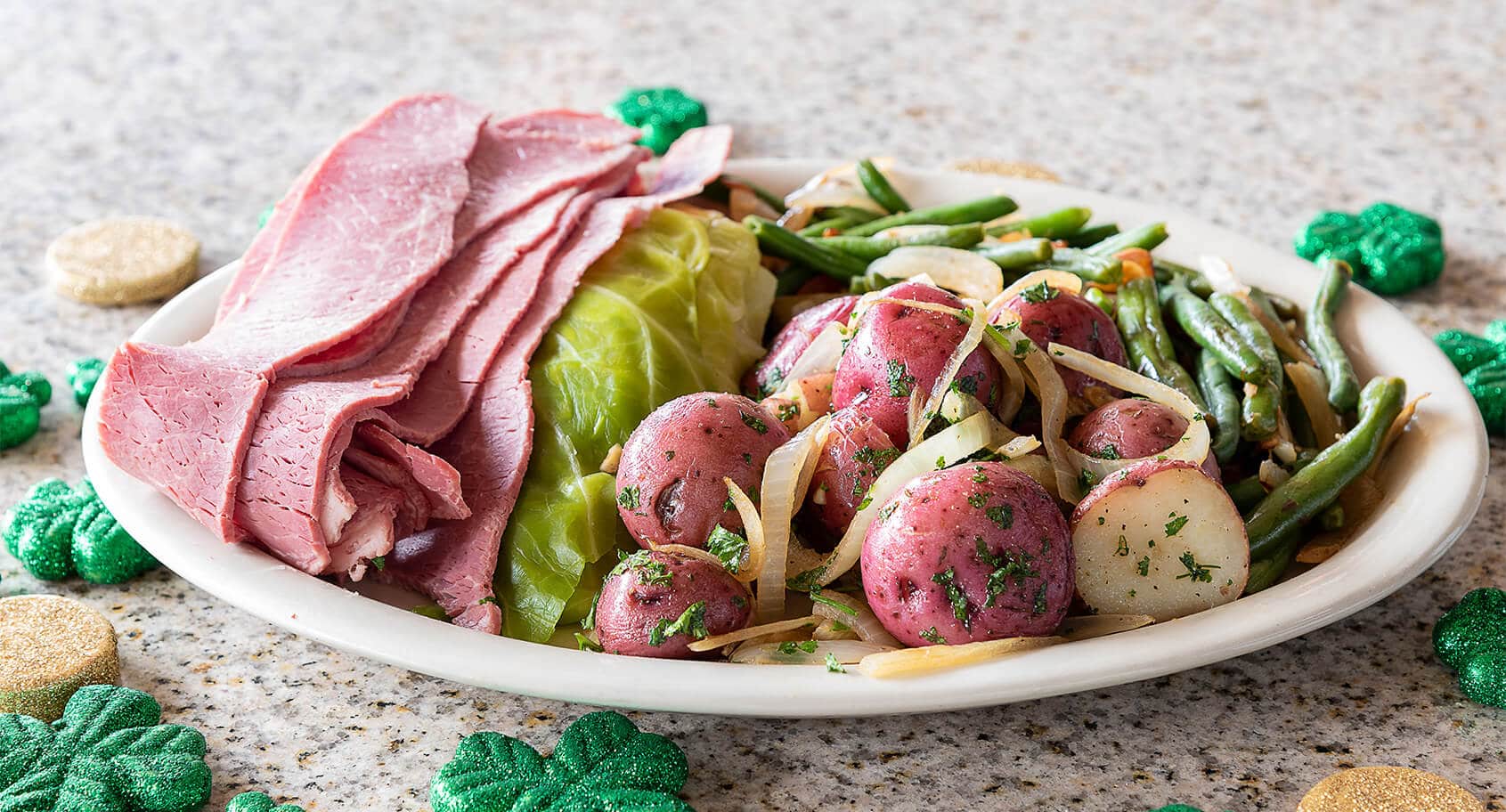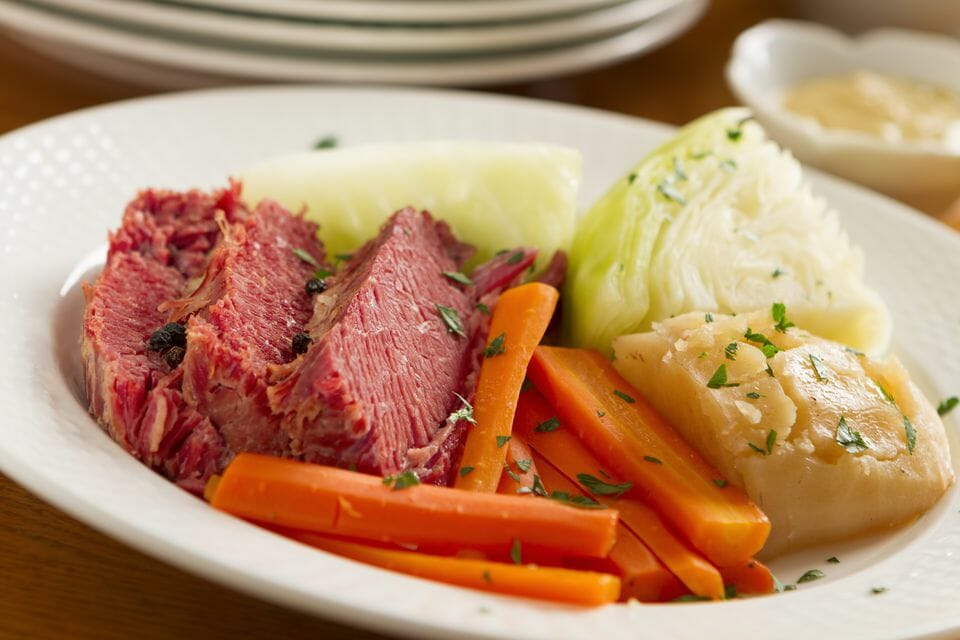Corned beef and cabbage is a classic St. Patrick’s Day meal, served in Irish pubs and households across America every March 17th. However, you may be surprised to learn that this “Irish” dish is actually more Irish-American than authentic Irish food.
So how did corned beef and cabbage become so closely linked with St, Patrick’s Day and Irish culture? Let’s unravel the tasty history behind this tradition,
The Irish Roots
In Ireland, corned beef and cabbage was rarely eaten Cattle were valued more for their milk and dairy than their meat, which was primarily reserved for the wealthy Lower classes subsisted on cheaper pork or bacon, usually boiled with cabbage or potatoes.
Fresh beef was either too expensive or considered “peasant food” not fit for honorable Irish tables. The only beef peasants ate was salted and preserved to make it last through the winter months. This cheaper “corned” beef got its name from the coarse salt kernels used to cure the meat, aka “corns” of salt.
The Birth of an Irish-American Dish
When Irish immigrants came to America, they were introduced to corned beef in Jewish delicatessens and butcher shops in major cities. Its similarity to Irish bacon made it an acceptable substitute. And its low cost made it more accessible than pork.
As historian Hasia R. Diner writes, in Ireland “they ate their beloved bacon; in America they turned to the considerably cheaper corned beef.” Corning was a cheaper preservation method than smoking, further dropping the price.
Cabbage was another cheap vegetable that Irish-Americans could afford, and its addition stretched the corned beef into a hearty, filling meal. Since preparing it only required a single pot, corned beef and cabbage soon became a favorite of Irish-American home cooking.
Bonding Over Food
In many ways, corned beef and cabbage came to represent the Irish-American experience. The underprivileged immigrant history it symbolized bonded Irish communities together.
Eating a meal that was unfashionable in Ireland but cherished in America demonstrated the idea of becoming American while still honoring your roots. Loving something simply because it came from the homeland carried significance for these displaced people searching for identity.
Food writer Elizabeth Zimmer writes, “For a people troubled by questions of identity, corned beef and cabbage offered ethnic continuity and stability.” It evoked nostalgia for the old country while staking a claim in the new one.
The St. Patrick’s Day Feast
As corned beef and cabbage took hold among Irish-Americans, it naturally made its way onto the menu for St. Patrick’s Day feasts.
St. Patrick’s Day, originally a Catholic feast day, had turned into a largely secular celebration of Irish culture and heritage in America. Corned beef dinners in Irish taverns and homes became a way to participate in that collective celebration.
The large scale manufacture of corned beef in the late 1800s also helped popularize it nationwide. Famous Irish-American brands like Pruitt-Santee and Swift Premium corned beef were mass marketed for home cooks. As corned beef became available fresh rather than just barrel-cured, its appeal and status grew.
Clearly, corned beef and cabbage fills more than just our bellies on St. Patrick’s Day. This hearty dish is also full of cultural symbolism and the long tangled history between Ireland and America. It represents the story of Irish immigration and the forging of hybrid cultural identities in the melting pot of America.
Trying an Irish-American Classic
If you’ve never had corned beef and cabbage before, St. Patrick’s Day is the perfect time to dive in! Look for a high-quality corned beef brisket and cook it low and slow until fork tender. Add some halved potatoes, carrots, and wedges of green cabbage during the last 30 minutes of cooking.
The corned beef should be incredibly moist and juicy when cooked properly. Lay it on a plate and slice against the grain of the meat. Pile it high with steamed cabbage, carrots, and boiled potatoes. Dig in while it’s hot!
I recommend topping that Irish-American classic with a dollop of whole grain mustard. Then wash it down with a cold Irish stout like Guinness for a St. Patrick’s Day meal you won’t soon forget. Sláinte!

The Feast of Saint Patrick

One could argue that the modern way of celebrating of St. Patrick’s Day is purely Irish-American. As covered in last year’s post, historically, the holiday was religious and reflective, celebrated by sharing cultural lore and honoring St. Patrick. However, there are many similarities between the historic celebrations of honoring the saint, and our traditions today. Observing the old ways in remembrance of their homeland helped unite the scattered Irish migrants. So, as they did in Ireland, Irish-Americans carried over the tradition of wearing shamrocks and enjoying Irish libations, such as Guinness and Irish whiskey. And today as in days of old, we enjoy soda bread and cabbage. Read our post from last year to get great recipes for both, as well as the full meal and leftovers.

Now that you know the reason we eat corned beef and celebrate the day, we get to the good part: cooking the meal! Butcher Boy Market makes grey corned beef and corned ribs, sells red corned beef, and serves grey corned beef dinners in our kitchen. Feel like making your meal at home? The key is to cook the beef slowly to create a tender, flavorful meal. Consult this guide from The Spruce on cooking corned beef three delicious ways: boiled, baked, or submerged in a slow cooker. Each way has its benefits. If you enjoy a crispy crust, then baking is for you! If you plan on spending the day out at a parade, slow cooker is the way to go. If you’re truly going traditional, then broiling will be the ticket to your perfect St. Paddy’s Day meal.
What Is Corned Beef?
Corned beef is typically made by salt-curing beef. Typically, brisket is the beef of choice, as it is a tough cut of meat thats made tender by a long, salt-filled cooking process. The brine used to cook the brisket down into corned beef is not unlike a pickling liquid. In fact, The Spruce Eats went so far as to call corned beef “essentially pickled beef.” (The actual term “corned beef” was reportedly coined in the 17th century by the English.)
Once done with the brining process, corned beef is super tender and easily sliceable, which is why you frequently see it in sandwiches (a classic Jewish preparation) and cut up in long slices next to cabbage (an Irish tradition).
Why do you eat corned beef and cabbage on St Patrick’s?
FAQ
Why are corned beef and cabbage associated with St. Patrick’s Day?
Corned Beef and Cabbage came to be associated with the Irish in the United States. In Ireland they produced large quantities of corn beef which was exported but was too expensive for the Irish themselves. They use bacon and cabbage instead as it was cheaper and pigs were raised for food and to pay rent.
Are you supposed to eat corned beef on St. Patrick’s Day?
Corned beef is not considered an Irish national dish and the connection to St. Patrick’s Day specifically originates as part of Irish-American Culture. And that is why we eat Corned Beef on St. Patrick’s Day.
Why do people eat corned beef and cabbage on New Year’s?
The meal, which is also often associated with St. Patrick’s Day, is meant to help bring good fortune into the new year. Folks opt for corned beef or pork for this meal as chicken and fowl supposedly bring bad luck because they dig into the dirt for food.
Why do they throw cabbage on St. Patrick’s Day?
Today, they throw the cabbages to honor that Irish tradition of using cabbages for their meals. And there’s even a traditional tossing technique. “We always ask our members to toss the cabbages not throw them overhand. Sometimes after a few drinks they can throw overhand, and that’s when people can get hurt,” he said.
